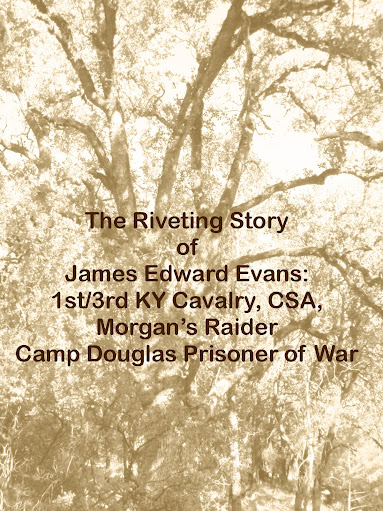“We rode over a rode cut up with gullies. The night was dark and the boys kept getting into them. We had to call one another to keep together in our places. We halted about midnight, and camped near a house on the right where Col. Morgan put up. We hitched along the fence and made our beds in the corners on the opposite side. I slept very well.”
~ Curtis R. Burke, 14th Kentucky Calvary, Co. B [i]
The Raiders looted Dupont of more that 2,000 Mayfield hams. Men tied as many hams to their saddles as they possibly could.
“Two thousand hams were stolen from Frank Mayfield’s meat packing plant as well as $1,600 worth of merchandise. The Raiders left town with hams dangling from their saddles …”[ii]
John Hunt Morgan slept for a few hours in the house of Thomas Stout.
“Sunday July 12th, 1863. Weather cloudy. We had a light shower early in the morning. Corn was very scare, but I managed to get a few ears for my horse. We saddled up and moved on to old Vernon or Dupont, Ind. and crossed the railroad with halting in town, but as we did so nearly all of our regiment broke ranks and went to a depot or warehouse where there was a lot of canvass hams said to be Yankee property, that is government property. We got a ham or two each. We had eat nothing that morning and were hungry. I took a ham and carried it in front of me. As I left I noticed some cars burning. In about an hour or so the yellow began to rub off of the hams on the boys cloths, and they began to throw them away. We were riding lively. Some would cut out a few choice pieces and throw the balance away. I held on to mine for some time longer, then cut a haversack full of the driest and leanest portions and left the balance on a fence post. Some of the hams were dropped in the road and left, others were given away at houses on the road. We had fine sandy roads to travel on. The horse pressing details never stopped for an hour. As we moved on every stable and lot was searched in sight and some times miles off the road.”
~Curtis R. Burke, 14th Kentucky Calvary, Co. B[iii]
The Raiders neared the town Vernon where Home Guard had assembled.
“July 11. Marched without hindrance through Vienna, New Philadelphia, Lexington, and Paris, and came to Vernon, where we found the enemy in great force. The enemy consisted of a large force of Volunteers and Militia. We made a flank movement, tore up all the railroads around Vernon, and then traveled all night to Dupont, where we rested and fed our horses. Like an irresistible avalanche we are sweeping over this country. Man never knows his powers of endurance ‘till he tires himself. The music of the enemy’s balls is now familiar and common as the carol of the spring bird which, unknowing of death and carnage around, sings today the same song that gladdened our forefathers.”
~ Lt. Col. James B. McCreary, 11th Kentucky Cavalry CSA[iv]
After sending in two demands for surrender to the town of Vernon and in return receiving a demand from Union General Love for his surrender, Morgan simply chose to skirt the town and avoid wasting any more time. By moving his men southeastward around the town during the two hours requested for women and children to be evacuated in preparation for battle, Morgan avoided battle, saved lives, and put more distance between himself and the perusing Union forces.
Conversely, such actions are fodder for the argument that Morgan was acting as little more than a bully and fighting only when his own forces vastly out numbered the poorly trained and organized home guards. Morgan relied heavily on a show of his cannons to produce the surrender of petrified civilians. Such arguments suggest that John Hunt Morgan was a terrorist rather than a warrior.
“At Vernon, Indiana, Governor Morton had posted a strong force of the ‘Home Guards’ to meet the invaders. Morgan made a demand on the commander of this force for surrender. This was refused and two hour’s time asked in which to remove the women, children and non-combatants. General Morgan was a chivalrous leader and generously granted the time asked for. These two exciting hours were consumed by the Home Guards hustling the women, children and old men away form the dangers of the battlefield, and as the hand of time marked the expiration of the truce, the citizens rolled up their sleeves, swallowed their “Adam’s Apple,” which had risen uncomfortably high in their throats, and prepared to wipe Morgan and his cavaliers off the face of the earth; but Morgan was ten miles away when the Home Guards advanced to pulverize him.”
~ Captain Theodore F. Allen, Seventh Ohio Cavalry [v]
“About dusk we came insight of Vernon, Ind. then took through the woods on our right. It was reported that there was too many Yanks in town to attack the place. General Morgan ordered an old cason to be burned. It was backed into a hollow and a man made a fire around it. In a few minutes it burst with a loud, noise, fortunately hurting no person. The man did not examine the cason before firing it and a shell was left in it. At first the boys thought that the Yanks were shelling us from town.”
~ Curtis R. Burke, 14th Kentucky Calvary, Co. B [vi]
Union leadership struggled to find arms, ammunition, and reliable reports regarding Morgan’s whereabouts as they tried to determine where Morgan would attempt to cross the Ohio River.
“Madison, July 11, 1863
(Via Vevay, July 12)
Major-general Burnside:
The railroad and telegraph wire cut at Vernon at 5 p. m., stopping train of re-enforcements for Madison. The enemy moved on Paris, then to Vernon. My forces consist of 1,200 infantry, four pieces of artillery, and 150 cavalry, imperfectly and poorly provided with ammunition. We have from 300 to 500 without arms. Can you send me men, arms, and ammunition? The later, for Austrian rifle .54 and smooth musket .69; also 3-inch and 6-inch pounder canister. Answer.
B. F. Mullen,
Colonel, Commanding Post.”[vii]
“Indianapolis, July 12, 1863.
General Boyle:
Morgan was at Vernon yesterday p.m., on the Madison Railroad, and was turned off from that point by General Love, who thinks he has taken the road to Madison. It is possible that the main body was still at Paris.
O. B. Willcox,
Brigadier, General.”[viii]
“Headquarters, Vernon, July 12, 1863 – 3:40 a.m.
General Burnside:
Arrived here at 6 last night, in time to answer Morgan’s second demand for town to surrender. Sent him word my force sufficient to hold the town. He said in thirty minutes would open his artillery. Got the women and children out as fast as possible, and made the best disposition possible with our small force and limited time. Expected an attack every minute, till 2 o’clock, when information I believe to be reliable leads me to believe he declines a fight and is hastening toward Madison; if so, he will reach the Ohio at Madison or vicinity about early dawn. I don’t think he can escape. Information looks as if his command was wearied out and he anxious about his escape.
Love.”[ix]
Cincinnati, July 12, 1863 – 6 a.m.
General Hartsuff:
The Indiana militia brought Morgan to bay at Vernon, on the Ohio and Mississippi Railroad, last night. He declined to fight, and retreated toward Madison. Hobson is close after him, and the gunboats are patrolling the river. We have a reasonable chance of catching him.
A. E. Burnside,
Major-General”[x]
ENDNOTES
[i] Journal of Curtis R. Burke.
[ii] Student Tour Guide, John Hunt Morgan Heritage Trail 1863
[iii] Journal of Curtis R. Burke.
[iv] Diary of James B. McCreary
[v] Allen, Theodore F. “In Pursuit of John Morgan,” Sketches of War History 1861-1865, Papers prepared for the Commandery of the Sate of Ohio, Military Order of the Loyal Legion of the United States 1896 -1903, pages 228-229.
[vi] Journal of Curtis R. Burke.
[vii] “Official Records of the Union and Confederate Armies,” Part I –Reports p. 725
[viii] “Official Records of the Union and Confederate Armies,” Part I –Reports, p.732
[ix] “Official Records of the Union and Confederate Armies,” Part I –Reports, p.733
[x] “Official Records of the Union and Confederate Armies,” Part I –Reports, pages 733-734.
Wednesday, January 7, 2009
Subscribe to:
Post Comments (Atom)





No comments:
Post a Comment